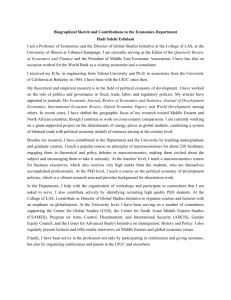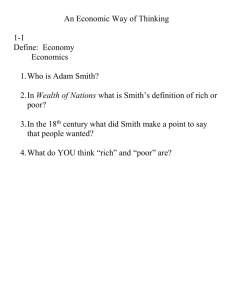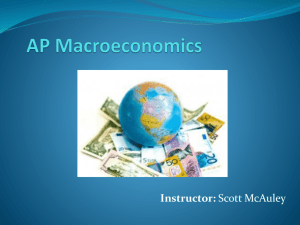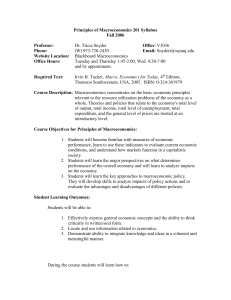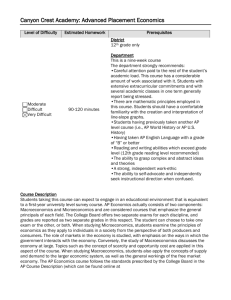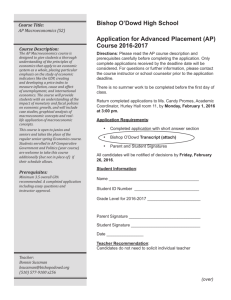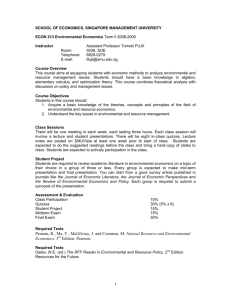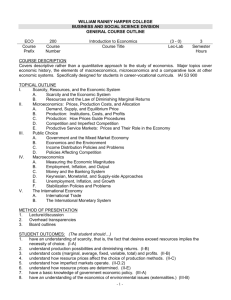Principals of Macroeconomics 201 Syllabus
advertisement
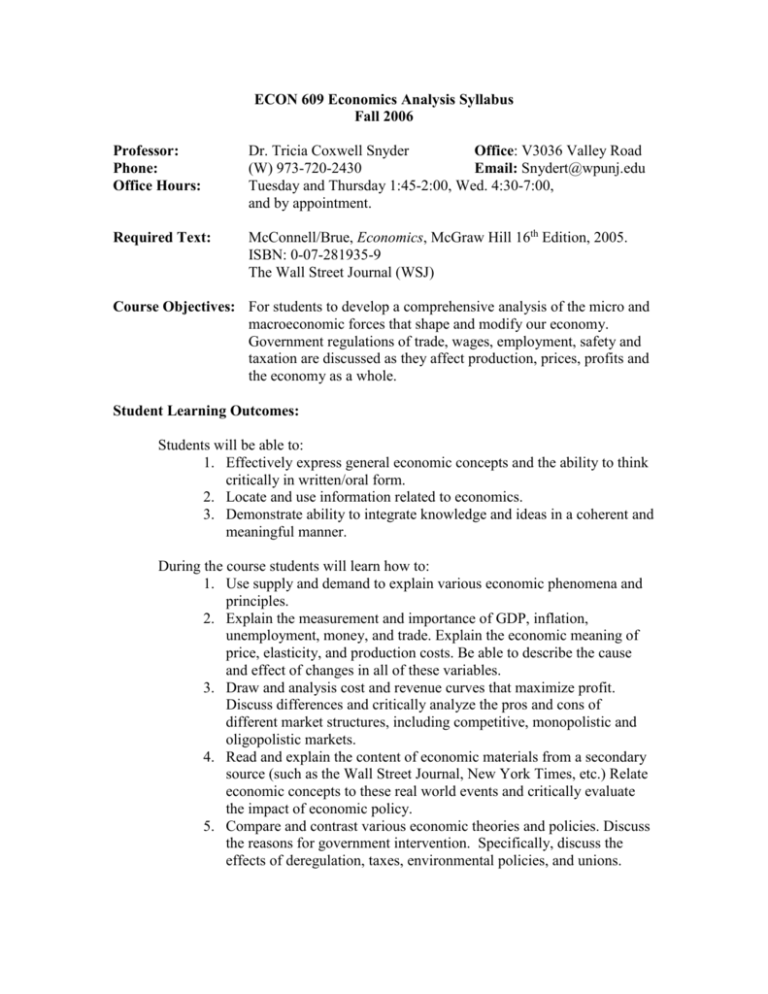
ECON 609 Economics Analysis Syllabus Fall 2006 Professor: Phone: Office Hours: Dr. Tricia Coxwell Snyder Office: V3036 Valley Road (W) 973-720-2430 Email: Snydert@wpunj.edu Tuesday and Thursday 1:45-2:00, Wed. 4:30-7:00, and by appointment. Required Text: McConnell/Brue, Economics, McGraw Hill 16th Edition, 2005. ISBN: 0-07-281935-9 The Wall Street Journal (WSJ) Course Objectives: For students to develop a comprehensive analysis of the micro and macroeconomic forces that shape and modify our economy. Government regulations of trade, wages, employment, safety and taxation are discussed as they affect production, prices, profits and the economy as a whole. Student Learning Outcomes: Students will be able to: 1. Effectively express general economic concepts and the ability to think critically in written/oral form. 2. Locate and use information related to economics. 3. Demonstrate ability to integrate knowledge and ideas in a coherent and meaningful manner. During the course students will learn how to: 1. Use supply and demand to explain various economic phenomena and principles. 2. Explain the measurement and importance of GDP, inflation, unemployment, money, and trade. Explain the economic meaning of price, elasticity, and production costs. Be able to describe the cause and effect of changes in all of these variables. 3. Draw and analysis cost and revenue curves that maximize profit. Discuss differences and critically analyze the pros and cons of different market structures, including competitive, monopolistic and oligopolistic markets. 4. Read and explain the content of economic materials from a secondary source (such as the Wall Street Journal, New York Times, etc.) Relate economic concepts to these real world events and critically evaluate the impact of economic policy. 5. Compare and contrast various economic theories and policies. Discuss the reasons for government intervention. Specifically, discuss the effects of deregulation, taxes, environmental policies, and unions. Topical Outline of the Course Content: SUBJECT READINGS INTRODUCTION TO ECONOMICS What is Economics? Ch.1-6 MACROECONOMICS Introduction to Macroeconomics (GDP, Economic Growth, Inflation, Unemployment) (DATASTREAM, Reuters) The Business Cycle, Aggregate Demand and Fiscal Policy Monetary Policy Economic Stability/Macroeconomic Theories Ch. 7,8, WSJ E-Trade Room Ch. 9-12, 18 Ch 13-15 Ch. 16-19 Mid-term Exam I (30%) Ch. 1-19 (Macroeconomics) INTERNATIONAL ISSUES Ch. 37, 38 International Trade International Finance Ch. 37 Ch. 38 MICROECONOMICS Elasticity Product Market (Profit, Total Revenue and Costs, Marginal Cost, Average Costs) (DATASTREAM, Reuters) Market Structure Labor Issues Regulatory Issues Distribution Issues Public Choice and Taxation Ch. 20 Ch. 21-22 Final Exam (30%) (International Issues and Micro) Ch. 20-25, 28, 31,32,34,35, 37-38 E-Trade Room Ch. 23-25 Ch. 28, 35 Ch. 32 Ch. 34 Ch. 31 Grading Policy Class participation: Economic Indicators Project: Tests: Attendance, Participation, In-Class Problems, and Take Home Assignments will count for 10% of your final grade. The Economic Indicators Project will count for 30% of your final grade. A Mid-term and Final exam will be given. Each exam will be weighted equally and is worth 30% of your final grade. Plagiarism or Cheating of any kind will result in a final letter grade of an F for the Course!!! If you have a question – ASK!!! If I am going to fast, please ask me to slow down. To help encourage the proper educational environment and out of courtesy for your fellow classmates, please turn of all cell phones and pagers prior to entering the classroom and be on time.


